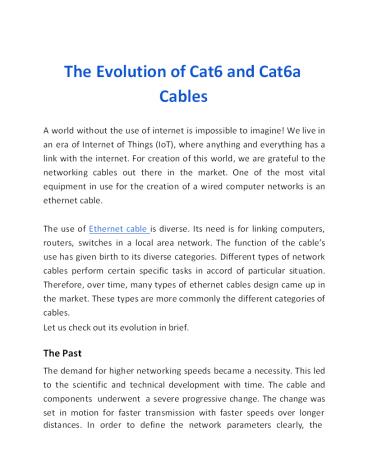The Evolution of Cat6 and Cat6a Cables - PowerPoint PPT Presentation
Title:
The Evolution of Cat6 and Cat6a Cables
Description:
Today, Cat6 has become the minimum requirement for installing network connections. Cat6a has also begun to gain popularity. It is much lighter and slimmer than earlier cables. Its use has been aggressive in the healthcare and educational institutes. Cat6a also provides power over ethernet, which gives it an edge over others. To Know More : – PowerPoint PPT presentation
Number of Views:46
Title: The Evolution of Cat6 and Cat6a Cables
1
The Evolution of Cat6 and Cat6a Cables
- A world without the use of internet is impossible
to imagine! We live in an era of Internet of
Things (IoT), where anything and everything has a
link with the internet. For creation of this
world, we are grateful to the networking cables
out there in the market. One of the most
vital equipment in use for the creation of a
wired computer networks is an ethernet cable. - The use of Ethernet cable is diverse. Its need is
for linking computers, routers, switches in a
local area network. The function of the
cables use has given birth to its diverse
categories. Different types of network cables
perform certain specific tasks in accord of
particular situation. Therefore, over time,
many types of ethernet cables design came up in
the market. These types are more commonly the
different categories of cables. - Let us check out its evolution in brief.
- The Past
- The demand for higher networking speeds became a
necessity. This led to the scientific and
technical development with time. The cable
and components underwent a severe progressive
change. The change was set in motion for
faster transmission with faster speeds over
longer
distances. In order to define the network
parameters clearly, the
2
introduction of copper categories was
inevitable. This was also necessary for
facilitating appropriate connecting
hardware. Earlier Categoribes In the later
part of the 1980s, the world saw the
introduction of Category 3 cables. It could
support voice services as well as 10BASE-T
Ethernet. However, this eventually became inapt
by the mid 1990s. By this time, Category 5
had become widely popular. It was able to
support faster network speeds up to
100Mbps. Cat5e The next phase of cable and
connector development came in with the preface
of Cat5e. It could support Gigabit network
applications with a higher efficiency. Cat5e
is in simpler terms, an enhanced version
of Category 5. On the other hand, Cat5e
standards brought with it some new and more
stringent crosstalk specifications. It did
allow Gigabit network applications and high
data transfer scenario. It had a much more
reliable functionality, enough for making
Category 5 obsolete. Cat6 Over the last
decade, Category 6 (Cat6) cable and
connectors have become a basic requirement.
Cat6 cables are extremely important for creating
a network that supports Gigabit
network applications. Moreover, a network which
supports bandwidth of up to 250MHz. Both Cat5e
and Cat6 plug into the same keystone Jack of your
Ethernet
jacks, routers, and switches. However, they
both have a distinct use,
3
design, and application. Both cables have
pair of cables with some twists of copper
wires. The Cat5e Keystone Jack supports speed
limit up to 1000 MBPS while the Cat6 cables has a
speed limit up to 10GBPS over 120-150 feet. The
cost of the cables varies by length and
differs from manufacturer to manufacturer.
The standard Cat5e costs generally around
0.20 per foot. Moreover, the standard Cat6
costs around 20 higher than the
Cat5e. During the introduction of Cat6, it
was much costlier than Cat5e. This made it almost
impossible for use. However, since then it has
proved its worth and its cost also reduced.
Today, Cat6 has become the minimum requirement
for installing network connections. Cat6a
Cables In Category 6A Cables, the a stands for
augmented. It supports data rates of 10
Gigabytes per second up to 100 meters. In
addition, it also supports a bandwidth of up
to 500MHz. It has begun to growing
popularity. The speed of cat6e has a 10GBPS
(Gigabit) limit up to 164 feet and thereafter its
speed is same as that of Cat5e. It is much
lighter and slimmer than earlier cables.
Its use has been aggressive in the
healthcare and educational institutes. Cat6a
also provides power over ethernet, which gives it
an edge over others.































